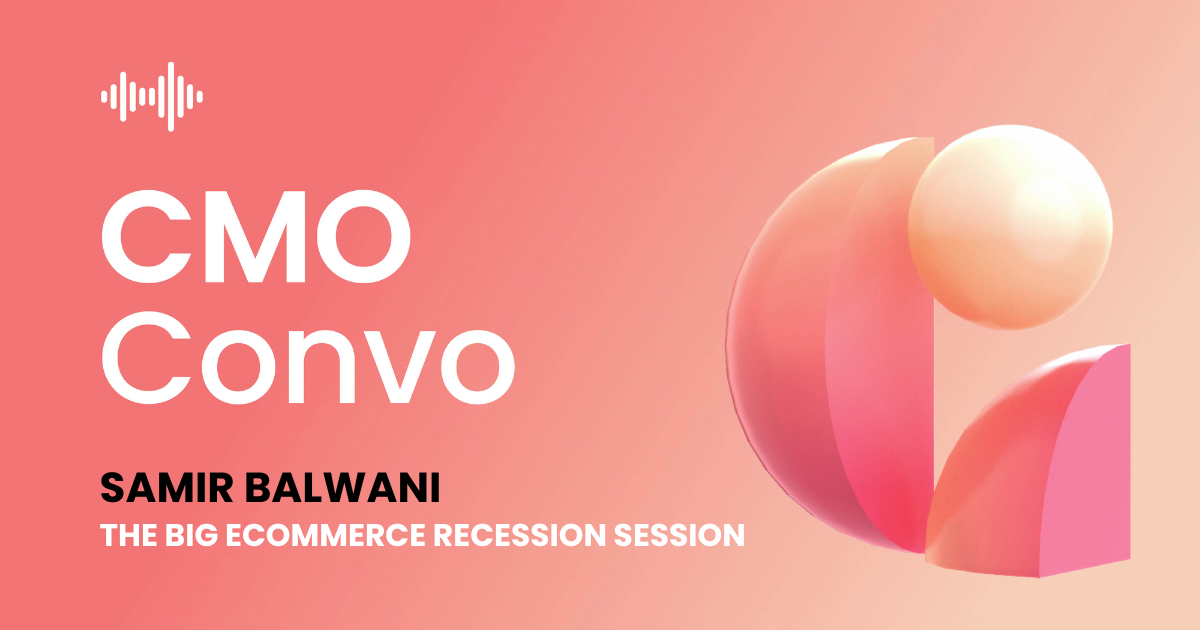This article is adapted from Samir's appearance on the CMO Convo podcast.
Ecommerce is undoubtedly going through a period of uncertainty. However, amidst this fog of confusion, one encouraging pattern is starting to clearly emerge: People are continuing to spend.
The evidence for this can be found in MasterCard's announcement that they surpassed earnings expectations in Q4. This revelation indicates that consumer spending during that period exceeded even the most optimistic projections. It's fantastic to witness such economic activity. What's more, this trend appears set to continue for the foreseeable future.

The labor market is presently incredibly tight, which means that more job openings are available than there are people to fill them. As a result, individuals are gainfully employed and possess the means to spend. However, the rising cost of living poses a challenge. Inflation has caused food prices, gas costs, and rent to surge, leaving consumers facing tough choices between wants and needs.
This cost of living crisis has had a discernible impact on our ecommerce clients. Notably, the effects are not evenly distributed among all brands and segments. Certain brands and segments have been hit harder than others. If a product fulfills a vital necessity, it naturally enjoys an advantage in this climate. Additionally, luxury and affluent customers seem less affected by the cost of living crisis compared to others. Consequently, businesses catering to this demographic are faring relatively well.
Moreover, certain product categories are experiencing a resurgence in the aftermath of the pandemic. Consider luggage and travel goods, for instance. After a prolonged period of restricted travel, individuals are now indulging in these items, redirecting their spending in these areas. Consequently, businesses offering such products are thriving.
Thus, while uncertainties persist, there are signs that the outlook is gradually becoming more certain. We are beginning to discern trends within different segments, which allows us to anticipate the behavior of consumers in the coming six to 12 months. By closely monitoring these shifts, we can better navigate the challenges and capitalize on emerging opportunities.
The changing role of CMOs in the era of uncertainty
Navigating these turbulent waters certainly presents its fair share of challenges. One unspoken rule of the C-suite in any business is that everyone is equal but not always at the same time. During periods of high growth with impressive numbers, CMOs wield considerable power. They’re the driving force behind the company's success, and everything seems to be falling into place. Their expertise and decision-making are highly valued.
However, as we enter a more conservative phase, where profitability and efficiency take center stage, the power dynamic begins to shift. The CFO assumes a more prominent role in the decision-making process. Questions like, "Are we making money?" and, "Are our financial decisions sound?" become increasingly important. This shift may come as a surprise to many CMOs who now realize they need to collaborate closely with their CFOs to ensure financial alignment.
One notable consequence of this shift is a more cautious approach to spending and decision-making. The era of pursuing grandiose ideas without considering costs is waning. It's no longer just about how much something costs, but rather what tangible outcomes can be expected. This poses a significant challenge for CMOs, as many of the initiatives that truly move the needle are innovative, risky, and difficult to measure.
While there are table stakes — such as performance marketing and direct mail campaigns — that yield predictable growth, the real challenge lies in the larger, more transformative investments. These engagements often come with ambiguous expectations and outcomes that are not easily quantifiable. Consequently, these are the very initiatives that are being subjected to budget cuts in the current landscape.
As a CMO, finding a balance between delivering measurable results and pursuing innovation can be daunting. It requires a strategic mindset, clear communication with the CFO, and the ability to navigate the shifting tides of uncertainty. By focusing on proven tactics while presenting a compelling case for larger investments, CMOs can position themselves as valuable contributors to the company's growth, even in challenging times.
Navigating risk and building certainty: Strategies for CMOs
Indeed, these conversations are among the most difficult ones to have with CFOs, particularly when the economic landscape is uncertain. However, there are strategies that many CMOs are implementing to address these challenges. Interestingly, these strategies exhibit consistency across different environments, be it agency life, startups, or even enterprise-level companies. Drawing from experiences in startups, where mini-recessions are common due to high burn rates, CMOs have learned how to navigate these situations.
When companies adopt a conservative approach, CMOs find themselves torn between investing in significant breakthrough ideas that can propel the business forward and investing in technology, data infrastructure, and internal processes to enhance operational efficiency. This often involves diverting resources from big ideas to drive investments in architecture and operational efficiency.
While this can be a viable option, the crucial aspect is understanding the timeline within which operational efficiency investments will yield returns. It's essential to evaluate the potential impact of not investing in those areas during the same timeframe. For instance, forgoing a brand campaign may have a one-year window where it might not significantly impact the business. Comparing this against the gains in operational efficiency during that same year becomes crucial for making informed decisions.
One area that CMOs should be cautious about cutting is media spend. While CPMs (Cost Per Thousand Impressions) tend to rise annually, as people start reducing their spending, CPMs can drop due to decreased demand. By capitalizing on this opportunity and maintaining media spend, businesses can position themselves advantageously. Holding on to funds while others are taking advantage of the market can result in missed opportunities.
Additionally, during a cost of living crisis and inflation, assuming that customers will completely stop buying what they currently buy may not be accurate. They may continue purchasing, but potentially not from your brand. However, it's important to remember that this shift is not specific to your brand alone—it affects the market as a whole. This presents a chance for brands to capture customers who are looking to change their buying preferences. By being present in the market during this time, businesses can seize this opportunity and weather the storm.
Data-driven decision-making becomes paramount in these circumstances. Having access to comprehensive data enables CMOs to make informed choices. It highlights the importance of investing in attribution tools and marketing mix modeling. By better understanding the impact of brand awareness campaigns and comparing them to other investments, CMOs can allocate resources effectively. This investment in attribution and modeling provides a valuable tool to create certainty in an otherwise uncertain world.
While the current landscape poses challenges for CMOs, strategic approaches that balance risk and operational efficiency, maintain media spend, and leverage data-driven decision-making can help navigate these uncertain times. By adopting these strategies, CMOs can position themselves for growth and resilience in the face of adversity.

Educating CFOs and navigating data challenges for new eCommerce brands
One aspect that often goes overlooked is the need to educate CFOs. By involving them and bringing them into the fold, it becomes possible to align marketing efforts with their goals, trade-offs, and expectations. CFOs are intelligent individuals, and marketing itself is increasingly becoming a numbers game. Understanding the CFO's objectives and collaborating to craft a compelling narrative that aligns with their vision can be highly effective.
The integration of CMOs and CFOs has been a long time coming, and it is an exciting development. More and more CMOs are entering the field with performance marketing backgrounds, which inherently entails a solid foundation in data and analytics.
Marketing has evolved from being purely creative and design-focused to a more balanced blend of creativity, strategy, tactics, and analytics. This shift benefits businesses as CMOs begin thinking from a revenue perspective and focus on driving ROI and long-term brand growth. Speaking the same language as CFOs facilitates smoother conversations and a more aligned approach.
To navigate the current landscape, constant conversations with the CFO are essential, ensuring they grasp baseline budgets that need to be maintained. It's crucial not only to demonstrate the cost savings achieved by cutting certain investments but also to highlight the missed opportunities associated with those cuts. Not undertaking certain initiatives always incurs a cost, and it's vital to ensure this understanding is effectively communicated.
For example, if it were clear that a downturn would last only three months, it might be feasible to cut back on various activities, assuming a rapid recovery afterward. However, the reality is that nobody knows the exact duration of a situation. Therefore, the focus should be on reducing or postponing activities that have a minimal downstream impact until absolutely necessary. The goal is to extend the runway as much as possible, weathering the storm and prioritizing resilience rather than aggressive growth during this period of uncertainty.
Having conversations with the CFO or CEO involves explaining the implications of cutting brand awareness campaigns. While it may seem like an immediate cost-saving measure, it's important to highlight the long-term consequences. By cutting brand awareness for a few months, immediate savings may be apparent.
However, it's essential to emphasize that this decision can have repercussions six months down the line. The funnel may not be refilled, and the performance marketing campaigns could suffer as a result. Understanding that these choices involve borrowing from the future to address present needs is crucial. Articulating this story and providing a clear explanation is where the real challenge lies.
The quest for certainty becomes all the more vital in the current climate. Every indication of stability is eagerly anticipated. For instance, the recent quarter-percent increase in interest rates by the US Federal Reserve hints at a potential bottoming out of the situation. However, it still leaves us uncertain about the extent and duration of the challenges we face.
This lack of clarity makes decision-making regarding brand awareness cuts even more challenging. Understanding the timeframe for which the downturn will persist plays a critical role. If it's projected to be a three to six-month period, decisions can be made accordingly. Consequently, the focus is on hedging bets and carefully evaluating future investments over the coming months.
In this climate of uncertainty, effective communication and strategic decision-making become paramount. CMOs must convey the potential trade-offs associated with cutting brand awareness, highlighting the long-term consequences and emphasizing the need for a balanced approach. By adopting this mindset, businesses can navigate the challenges ahead and position themselves for success in the face of an uncertain future.
Overcoming fear and leveraging expertise to navigate uncertainty
Education and showcasing the data and impacts of different tactics play a crucial role in addressing the fear of taking risks. Agency partners often prove invaluable in providing thought leadership and expertise to help tell the story and explain the roles of different marketing strategies.
For instance, when clients consider cutting brand awareness campaigns, past data can be analyzed to illustrate the impact of such decisions. This examination allows businesses to understand the consequences of these actions and evaluate the downstream effects on their brand. While this recession is unique and consumer behavior is unusual, the strategic decisions and their downstream impacts remain consistent regardless of the economic climate. The amplitude of the impact may vary, but the fundamental effects persist. Cutting brand awareness spend may provide temporary relief, but it will have implications down the line. The key lies in understanding the long-term consequences and considering the competitive landscape within one's segment.
Another important aspect for brands to consider is whether the sales anticipated for future years have already been accelerated due to pandemic-related factors. Reflecting on the impact of last year's sales and the assumptions made in forecasting future growth is crucial. It's necessary to ensure that forecasts are realistic and not based on the assumption that the previous year's accelerated sales will continue at the same rate.
Recognizing any shifts in consumer behavior and market dynamics allows for a more accurate assessment of growth plans and right-sizing strategies. Many eCommerce and tech companies are facing layoffs as they come to terms with the realization that consumer behavior and profitability have changed. Adjusting growth plans based on realistic expectations is essential in navigating this uncertain landscape.
Ultimately, embracing calculated risks and leveraging expertise while being honest about the impact of past events on future forecasts can help CMOs make informed decisions. By evaluating data, engaging in strategic conversations, and adapting to the evolving market, businesses can position themselves for growth and resilience, even amid uncertainty.

Collaborating with key stakeholders for holistic forecast planning
For eCommerce, the CMO does not operate in isolation but rather relies on close collaboration with various stakeholders. One crucial aspect is having a deep understanding of the user experience from a product perspective. Ensuring the website and overall product performance are optimal is essential. No matter how well a brand is marketed, if the user experience is lacking, it becomes challenging to drive conversions. Therefore, close alignment with product teams is vital.
Merchandising is another key component. The CMO should work closely with merchandising teams to ensure the right product fit and compelling offers are available. This collaboration ensures that the customer journey is optimized and motivates the ultimate purchase decision.
Of course, maintaining a strong partnership with the CFO is critical to secure the necessary budget, evaluate margins, and support customer acquisition efforts. Financial considerations play a crucial role in decision-making and resource allocation.
From a data perspective, another increasingly relevant role is the Chief Digital Officer. This position often serves as the gatekeeper for customer lists, data analytics tools, and website personalization capabilities. Collaborating closely with this team provides valuable insights to inform media investment decisions. In the current landscape, where efficiency, profitability, and growth are essential considerations, having a comprehensive understanding of the impact and future outlook is paramount. Leveraging data and analytics becomes increasingly valuable in making informed choices.
Collaboration with stakeholders such as product teams, merchandising teams, the CFO, and the Chief Digital Officer enables a holistic approach to forecast planning. By working together, CMOs can align marketing efforts with the user experience, optimize product offerings, and make data-driven decisions that lead to efficient and profitable outcomes.
Navigating uncertainty and shifting mindsets towards profitability
It’s still early to pinpoint specific brands and their strategies, as many organizations are currently reviewing their annual forecasts and reassessing goals. The high level of uncertainty has extended this process, with CFOs seeking additional data and stability to make more accurate forecasts. However, it is crucial for CMOs to push for timely decision-making and revisit forecasts as new information emerges. Decision paralysis due to uncertainty is a real challenge, and proactive communication with the CFO is essential.
While it may be too early to identify individual brands, one important trend emerging is a greater focus on overall expenses and return on investment (ROI). Brands are reconsidering their advertising costs, evaluating the tools they invest in, and becoming more ROI-focused. The emphasis is shifting towards telling the profitability story rather than solely focusing on revenue growth. This mindset shift is significant and will be learned over time by many CMOs who previously didn't have to consider it.
Furthermore, CMOs need to approach growth with a dual perspective of money and time. They can either invest more money to expedite growth or allocate less money and allow more time for growth to occur. This perspective enables CMOs to have realistic conversations with their CEO and CFO about achievable growth targets. It's crucial to maintain transparency and honesty regarding growth expectations, considering the shifting market dynamics. Setting realistic goals while acknowledging the fluidity of the situation is key.
While specific brand examples are not yet available, the shift toward profitability as a primary focus is becoming evident. CMOs should engage in open conversations with their CFOs, pushing for timely decision-making and revisiting forecasts as new information emerges. The emphasis on ROI and aligning growth expectations with financial realities will be a significant aspect of navigating these uncertain times.
Golden rules for eCommerce CMOs in uncertain times
So we’ve reviewed the various challenges and considerations for eCommerce CMOs during these uncertain times. To tie everything together, here are some golden rules for approaching purchasing and marketing strategies:
Establish a clear media plan and forecasts.
Having a well-defined media plan and accurate forecasts are essential for effective resource allocation. It allows you to understand where and why you're investing, as well as the expected returns. This clarity helps improve efficiency, tells a strategic story to the CFO, and ensures that budgets are used wisely.
Implement clear experimentation plans.
Developing clear experimentation plans enables you to test and learn. Define what you're working on, why you're experimenting, and your expected outcomes. This allows for informed internal conversations about the success or failure of experiments, leading to more refined strategies.
Determine breakeven return on ad spend (ROAS).
Collaborate with the CFO to understand your margins and product mix. Calculate your breakeven ROAS and target return on ad spend. By setting clear benchmarks, you can align marketing goals with financial realities. This clarity becomes the foundation for discussions with the CFO, CEO, and your team, ensuring everyone is on the same page regarding performance targets.
By following these golden rules, eCommerce CMOs can navigate uncertainty with confidence. They empower you to make informed decisions, allocate resources effectively, and align marketing strategies with financial objectives. Ultimately, they lay the groundwork for driving growth and profitability in challenging times.
A little about the author
Hello, I’m Samir Bhawani, CEO and founder of QRY. I've been in digital marketing for about 20 years and have had the pleasure of working on the agency side, for small startups, scaling startups, and enterprises.
I realized that there was a gap for really specialized media agencies, with three key things, a consultative point of view, a truly repeatable process, and a business-minded viewpoint. It was always marketing first or media first, and I really wanted to have an agency that was business minded. That's where QRY was born.
A lot has changed over the last few years in the face of the pandemic and growing inflation that's impacted the projected growth of eCommerce. So I’m excited to be able to take you through the current state of eCommerce marketing, what CMO's priorities need to be, and the tools and strategies you need to succeed.
Navigating the complexities of eCommerce can be tricky, but it's easier if you have help! And what better help could there be than a global network of CMOs and marketing leaders? Well, you can find that by joining the CMO Alliance Community Slack channel today, for free!




 Follow us on LinkedIn
Follow us on LinkedIn




